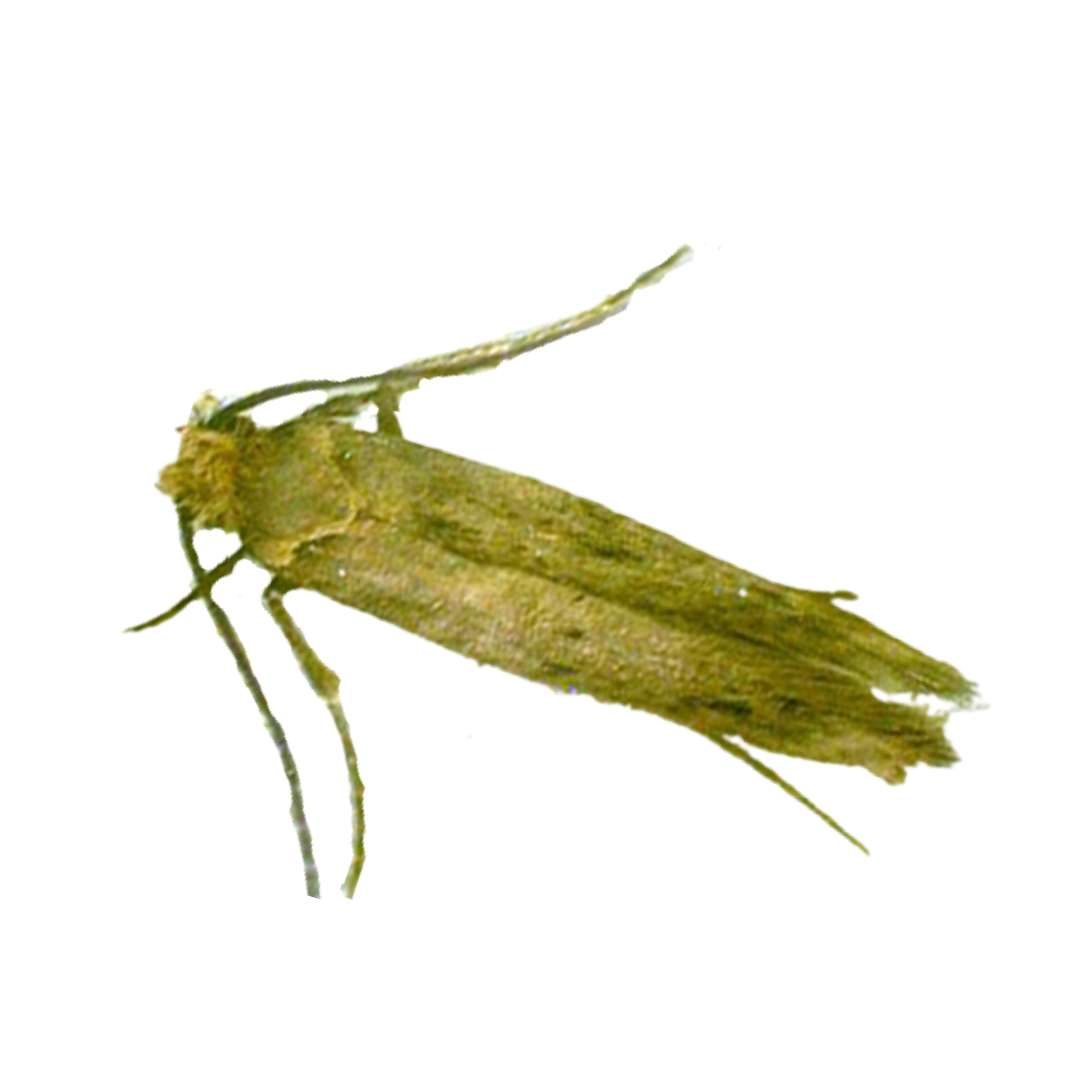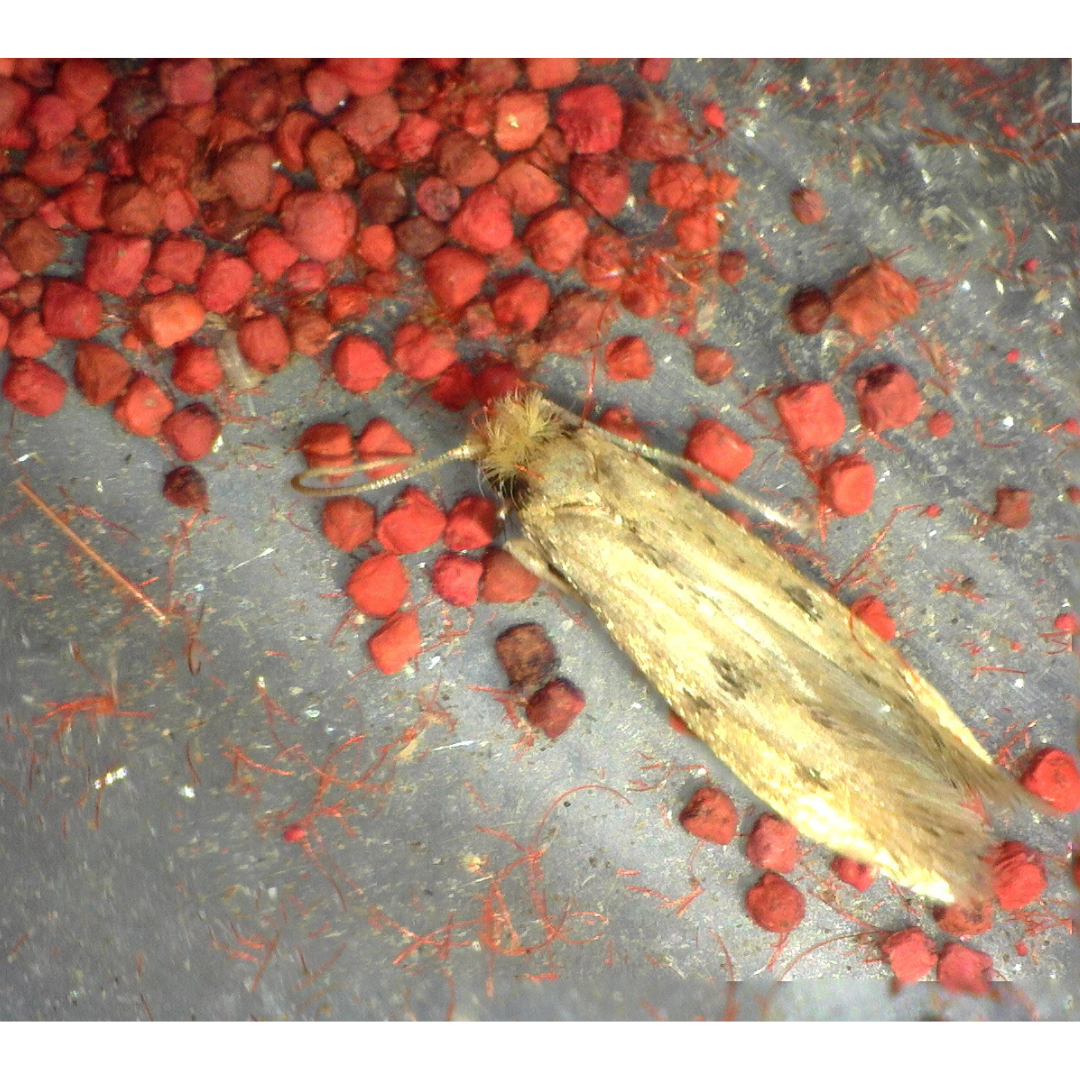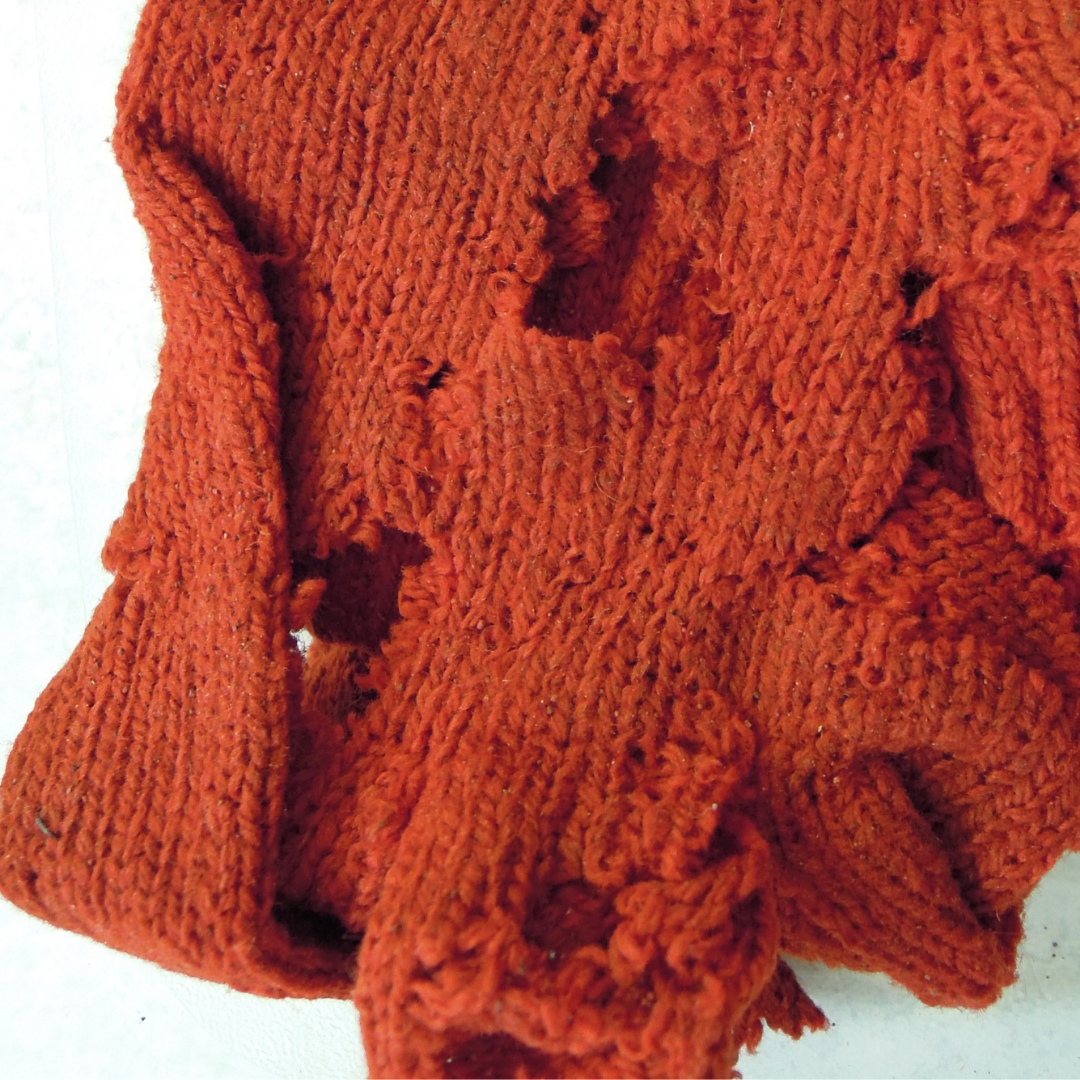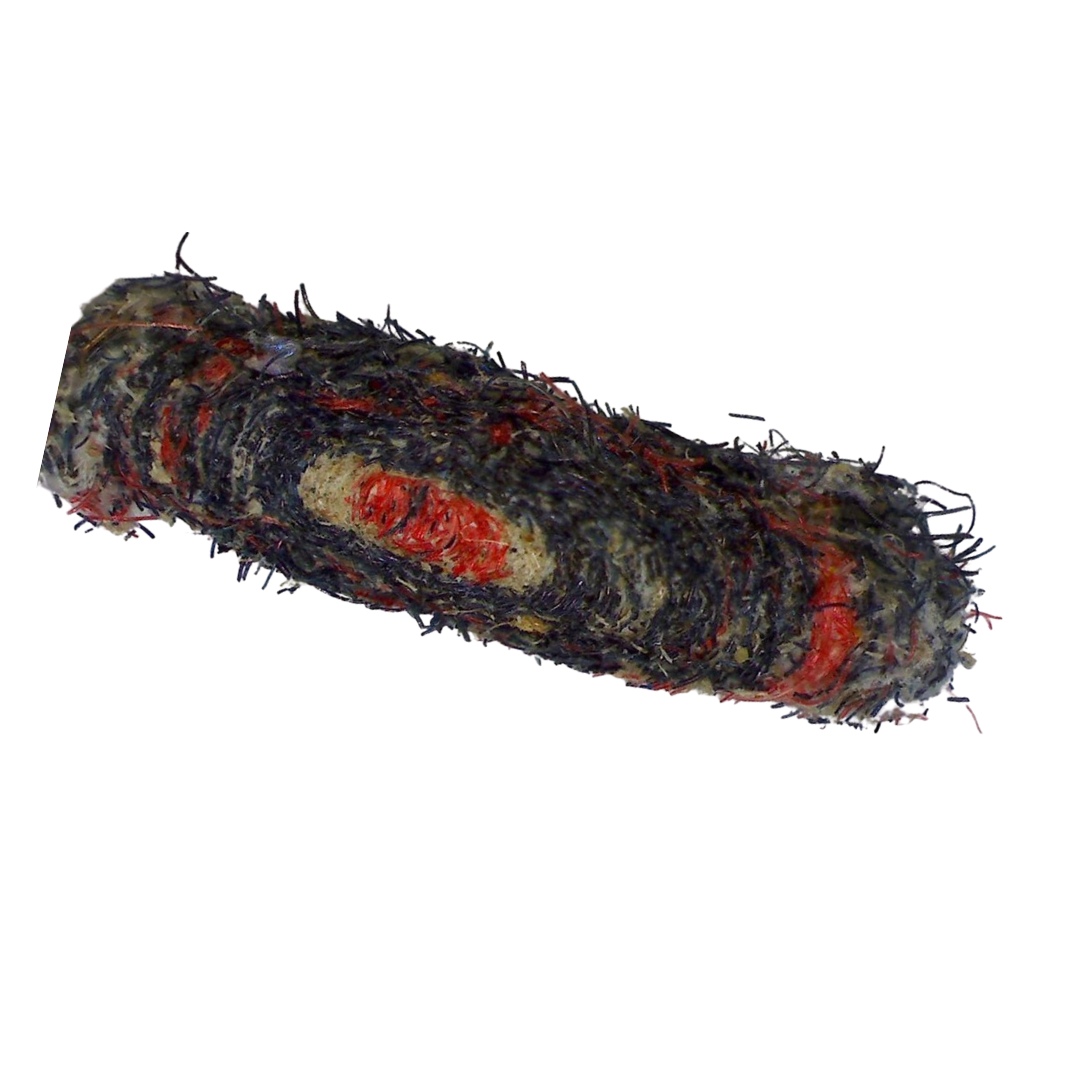Casemaking Clothes Moth (Tinea pellionella)





How do you monitor for Casemaking Clothes Moth?
Casemaking Clothes Moth Description
Casemaking Clothes Moth Adults: Up to 8 mm (0.3 inches) long with shiny grey to brown 1-3 small spots on wings. Has a small tuft of brown hairs on top of head.
Casemaking Clothes Moth Eggs: Oval, ivory in color and 1 mm (0.04 inches) long.
Casemaking Clothes Moth Larvae: Creamy white, black head capsule, 13 mm (0.5 inches) long, found within a silken case that it carries.
Casemaking Clothes Moth Pupae: Pupal cases are whitish; often patterned with colored fibers; sometimes hidden in fabric or fur; up to 13 mm (0.5 inches) long.
Casemaking Clothes Moth Life Cycle
Adult moths live for 15-30 days. Mated females can lay 40-50 eggs singly or in groups. Eggs hatch in 4-10 days in warmer months and up to 30 days in cooler months.
Larvae feed and become mature in 35 days or and up to 30 months depending on food quality, temperature and humidity.
Pupation will occur in proximity to and within infested materials. Adults will emerge from the pupae in 8 to 40 days depending on temperature.
Damage & Detection for Casemaking Clothes Moth
Casemaking clothes moth larvae damage woolens, silks, furs and materials made with hair and feathers. The primary means of detection of casemaking clothes moth is the presence of silken cases that contain larvae.
During pupation, the silken cases can be found hanging from vertical surfaces and under horizontal surfaces such as shelves or bottoms of furniture.
These pupal cases can also be found within piles of carpet and rugs or underneath these materials.
Granular frass, the size of ground pepper, can be found in, on, and under fabric, furs, taxidermy mounts, hanging clothes in closets, rugs, carpets, and upholstered furniture. The use of pheromone traps and inspections can determine location and degree of infestation.
Fun Facts about Casemaking Clothes Moth
Sometimes confused with the webbing clothes moth (Tineola bisselliella) and brown dotted clothes moth (Niditinea fuscella).
Other common names for the casemaking clothes moth include common clothes moth and clothes moth.
Like many clothes moth species, adult Casemaking clothes moths do not eat. Their larvae are vivacious feeders and damage natural fibers.
Casemaking clothes moths initiate flight at temperatures above 12.5°C (55°F).
The pheromone that attracts Casemaking clothes moths also attracts other moth species including:
Webbing clothes moth (Tineola bisselliella)
Brown dotted clothes moth (Niditinea fuscella).
Monitoring Tips & Tricks for Casemaking Clothes Moth
Casemaking Clothes Moth Monitoring Guidelines
Lure
The species-specific Casemaking Clothes Moth BULLET LURE® is the recommended lure to use when monitoring for this insect. It contains sex pheromone to attract male moths.
The multi-species Clothes Moth BULLET LURE® can be used when multiple species of clothes moths are present, or a customer is unsure which clothes moth is causing damage. Both types of pheromone lures have an effective duration of attraction of 90 days.
Lure Storage
Keep unopened lures in cool storage (less than 60° F) or place in the freezer for extended storage. Lures can remain frozen for up to 24 months or at room temperature for 12 months to retain their full effectiveness for use afterwards.
Trap Designs Used with Lure
NOSURVIVOR TRAPS are diamond shaped sticky traps that can be hung from many locations. This design is the preferred trap for this moth that flies well.
FLAT TRAPS are a low-profile sticky trap which are another option that should be placed on a flat surface when a hanging trap is not preferred by customers.
Casemaking Clothes Moth Pheromone Traps
Trap Placement & Use
Trap Placement Techniques
Pheromone traps can be placed year-round but are especially recommended when temperatures exceed 12.5°C (55°F). Hanging traps are more effective at capturing Casemaking clothes moths compared to flat traps.
Place hanging casemaking clothes moth pheromone traps 1.5 m (5 feet) above ground or at eye level to allow for easy inspection when monitoring traps. In areas such as a closet or home, place one or two pheromone traps per room.
In commercial areas such as warehouses or museums, place pheromone traps 7.5–15 m (25–50 feet) apart to determine the presence or absence of Casemaking clothes moths. Increase pheromone trap density to 4.5–7.5 m (15–25 feet) apart to help locate source of Casemaking clothes moths.
Keep pheromone traps 7.5 m (25 feet) away from exterior doors. Casemaking clothes moth pheromone traps are best utilized in areas that store items that contain natural fibers such as wool, hair, feathers, furs, and upholstered furniture (containing natural wools and leathers).
Trap and Lure Maintenance
Replace traps when glue is filled with insects or becomes dusty. Replace pheromone lures every 90 days. Replace all pheromone lures in a location at the same time. Do not cut the cap off the bullet lure. Do not stagger lure replacement over several weeks. Record date and number of catches to identify trending information.
Casemaking Clothes Moth FAQs
What do Casemaking Clothes Moths look like?
The casemaking clothes moth, Tinea pellionella, also called the casebearing clothes moth, case bearing clothes moth or, case making clothes moth adults are up to 8 mm (0.3 inches) long with shiny grey to brown 1-3 small spots on wings.
Has a small tuft of brown hairs on top of head. Casemaking clothes moth eggs are typically too small to see with the naked eye, but are oval in shape, ivory in color and 1 mm (0.04 inches) long. Casemaking clothes moth larvae are creamy white in color with a black head capsule, 13 mm (0.5 inches) long, found within a silken case that it always carries with it.
Pupae: Pupal cases are whitish; often patterned with colored fibers; much of the time, these pupal cases are found hanging downward form a horizontal surface above its food source, such as the ceiling of a closet or the bottom of a shelf directly above infestation; up to 13 mm (0.5 inches) long.
What is the life cycle of Casemaking Clothes Moths?
Adult moths live for 15-30 days. Mated females can lay 40-50 eggs singly or in groups. Eggs hatch in 4-10 days in warmer months and up to 30 days in cooler months. Larvae feed and become mature in 35 days or and up to 30 months depending on food quality, temperature and humidity. Pupation will occur in proximity to and within infested materials. Adults will emerge from the pupae in 8 to 40 days depending on temperature.
How to get rid of Casemaking Clothes Moths?
The first step in how to get rid of casemaking clothes moths is determining where the clothes moth infestation is originating from. This is best done by using clothes moth pheromone traps. Pheromone traps placed closest to clothing moth infestations will capture more moths.
By checking and comparing traps, one can determine if the source is coming from a certain area, room or closet. The ability to narrow down the source of the infestation allows the user to visually identify individual objects, clothing or rugs that are a breeding food source for clothes moths. Once these items are located, an extermination method can be determined that will answer the question: How to kill clothes moths?
The answer to this question is typically achieved through bagging and freezing smaller objects for several days. Some items can be run through the hottest cycle in a clothes dryer for a full 60 minutes.
Larger items, such as wool rugs can be taken outdoors and beaten to dislodge any moth adults, larvae and eggs. Steam cleaning or chemical treatments can also kill moths on carpets or on furniture that contains natural animal fibers.
Join Our Informed Community
Receive the latest industry as soon as they are published.




